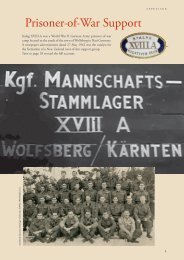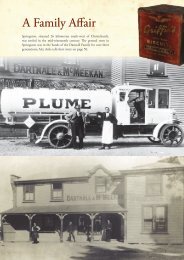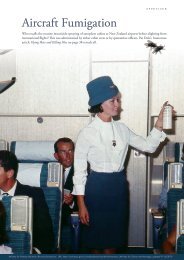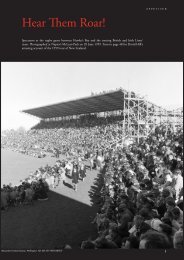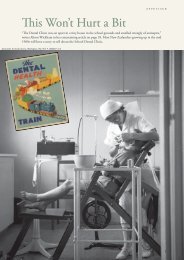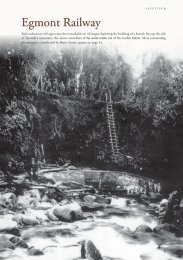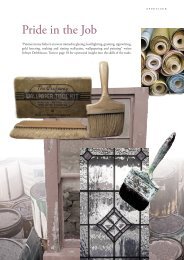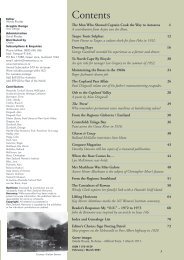You also want an ePaper? Increase the reach of your titles
YUMPU automatically turns print PDFs into web optimized ePapers that Google loves.
APPETISER<br />
Mud-bound Parliamentarians<br />
The ‘Winterless North’ Tour (16-30 January 1917) comprised a delegation of parliamentarians, dignitaries,<br />
journalists, and businessmen who travelled in a procession of 33 motor cars around Northland to witness poor<br />
roading conditions. Hampered by bad weather, the roads proved a challenge - demonstrated by this car bogged<br />
down in mud between Herekino and Kohukohu - and only ten cars completed the journey.<br />
Read the full account by Fiona Davies in our Northland regional section.<br />
Courtesy: Whangarei Museum, Kiwi North Ref: 1995.56.41 (below).<br />
Courtesy: Graham Stewart<br />
1
EDITORIAL<br />
Dear Readers,<br />
We’ve reached another milestone. The 25th Anniversary was celebrated at the end<br />
of 2020 and now <strong>New</strong> <strong>Zealand</strong> <strong>Memories</strong> marks <strong>150</strong> issues. Little did I imagine the<br />
dizzy heights of <strong>Issue</strong> <strong>150</strong> when I first took over as a hesitant editor at <strong>Issue</strong> 11.<br />
Nor did I ever imagine that a constant flow of varied and splendid stories would<br />
keep our pages full. But they do. Thank you to the multitude of contributors who<br />
have been part of our story thus far. Bless you all.<br />
With the demise of the cheque, and its imminent removal from <strong>New</strong> <strong>Zealand</strong><br />
society, I was keen to pay homage to this disappearing icon, one that has served<br />
the country well since 1840. I was directed towards the knowledgeable Andrew Clifford of the Numismatic<br />
Society and the result, an excellent article on the history of the cheque in <strong>New</strong> <strong>Zealand</strong> illustrated with rare<br />
examples.<br />
Ray Salisbury’s fine leading article opens in Nelson, the date 1842, and paints a fascinating picture of the<br />
challenges facing early settlers in their search for suitable grazing land. Their tenacity in face of hardships is<br />
astounding.<br />
Paul Aubin’s unique brand of humour is applied to the topic of dancing and, in particular, to the dances held<br />
in his hometown… and the consequences of those weekly gatherings. “The Dunedin Town Hall Dance, over<br />
its many Saturday nights, acquired a legendary status for expediting so many hundred, or thousands of engagements<br />
and matrimonies,” writes Paul. This was not only true of the Deep South; local dances throughout the country<br />
proved to be the catalyst for many a budding romance. And on the note of romance, David Hill is sure to win<br />
over the hearts of the ladies - and score brownie points from Mrs Hill - with his very sweet finale to The Big<br />
Night.<br />
Keep safe and vigilant as the vaccination programme rolls out to the general public, and I’ll be back to chat<br />
with you again in August after I’ve had my injection.<br />
Wendy Rhodes,<br />
Editor<br />
For just $79 you receive an annual<br />
subscription to <strong>New</strong> <strong>Zealand</strong> <strong>Memories</strong>.<br />
Six superb issues direct to your letterbox.<br />
A G i f t o f D i s t i n c t i o n<br />
Surprise a friend or relative with a gift subscription.<br />
We will even gift wrap the first issue, include a gift<br />
card with your personal message and post it direct.<br />
Freephone: 0800 696 366 or<br />
Freepost: 91641<br />
PO Box 17288<br />
Green Lane, Auckland 1546<br />
Email: admin@memories.co.nz<br />
Subscribe and Save!<br />
Visit our website w w w.memories.co.nz for subscriptions and gift ideas.<br />
Order online securely today and pay via internet banking or credit card.<br />
2
Editor<br />
Wendy Rhodes<br />
Graphic Design<br />
Icon Design<br />
Administration<br />
David Rhodes<br />
Distributed by<br />
Ovato<br />
Subscriptions & Enquiries<br />
Phone tollfree: 0800 696 366<br />
Mail: Freepost 91641,<br />
PO Box 17288, Green Lane, Auckland 1546<br />
email: admin@memories.co.nz<br />
www.memories.co.nz<br />
Annual Subscription $79 for six issues<br />
(Price includes postage within NZ)<br />
Contributors<br />
Alexander Turnbull Libraries<br />
Aubin, Paul<br />
Auckland City Libraries<br />
Baker, Ken<br />
Bourn, Christopher<br />
Clifford, Andrew<br />
Davies. Fiona<br />
Dillon, Miles<br />
Dykes, Mervyn<br />
Hill, David<br />
Hirst, Helen<br />
McLeod Family<br />
Moore, Anne<br />
Mytton, Joan<br />
Nelson Provincial Museum,<br />
Pupuri Taonga O Te Tai Ao<br />
Paviour-Smith, John<br />
Paviour-Smith, Robert<br />
Peka, June<br />
Pickmere, Alan<br />
Russell, Tony<br />
Salisbury Family archives<br />
Salisbury, John Park<br />
Salisbury, Ray<br />
Stewart, Graham<br />
Subritzky, Mike<br />
Sullivan, Peter<br />
Tairawhiti Museum<br />
The Treasury, Thames<br />
Thorn Family Archives<br />
Waipu Museum<br />
Wairarapa Archive<br />
Whangarei Museum, Kiwi North<br />
Wood, Bev<br />
Opinions: Expressed by contributors are not<br />
necessarily those of <strong>New</strong> <strong>Zealand</strong> <strong>Memories</strong>.<br />
Accuracy: While every effort has been made to<br />
present accurate information, the publishers take no<br />
responsibility for errors or omissions.<br />
Copyright: All material as presented in<br />
<strong>New</strong> <strong>Zealand</strong> <strong>Memories</strong> is copyright to the publishers<br />
or the individual contributors as credited.<br />
ISSN 1173-4159<br />
June / July 2021<br />
Contents<br />
Amazing Grazing 4<br />
Ray Salisbury’s article is set in the Nelson region.<br />
A Night “Round the Telly” 12<br />
Television memorabilia from Christopher Bourn.<br />
The Big Night 16<br />
David Hill was a school prizegiving recipient.<br />
The Town Hall Dance 18<br />
Paul Aubin recalls Dunedin’s Saturday night dance scene.<br />
From the Regions: Northland 24<br />
In Loving Memory of Morrie 34<br />
Bev Wood pays tribute.<br />
Centrefold: Tramping Party 36<br />
Head of the Lake, Te Anau.<br />
Reader’s Response: Triple Tragedy 43<br />
A Brief History of Cheques in <strong>New</strong> <strong>Zealand</strong> 44<br />
Written by Andrew Clifford.<br />
Once a Jolly Swagman… 48<br />
Mervyn Dykes gives an account of an extraordinary “swagger”.<br />
Afternoon Tea 51<br />
Quite an occasion in the 1940s as recorded by Helen Hirst.<br />
“Gotta Milk the Blimmin’ Cow” 52<br />
Tony Russell relates a story from his mid-Canterbury upbringing.<br />
<strong>Memories</strong> of Remuera Primary School During World War II 54<br />
Ann Cryer (nee Patton) was enrolled at school in 1938.<br />
From the Regions: Bay of Plenty / Coromandel 58<br />
Mailbox 69<br />
Index and Genealogy List 70<br />
Editor’s Choice 72<br />
In Tribute<br />
Cover image:<br />
Inglewood in Taranaki painted<br />
by Christopher Aubrey, 1896.<br />
Collection of Puke Ariki<br />
3
FEATURE<br />
Amazing Grazing<br />
Ray Salisbury<br />
Land Hunger<br />
The <strong>New</strong> <strong>Zealand</strong> Company’s second settlement, Nelson, was established in 1842. The settlers were promised<br />
more real estate than what was available. To alleviate the scarcity of pastoral land, a handful of European<br />
explorers began to penetrate the hinterland of the Nelson province, up the Motueka River and south as far as<br />
the Nelson Lakes.<br />
Māori told tales of extensive grassy plains in the north-west corner of the South Island – this was the primary<br />
motivation for Charles Heaphy and those who followed him. During 1846, Thomas Brunner participated in at<br />
least four harrowing expeditions, including one down the Buller gorges in a survival epic known as the greatest<br />
exploratory journey in <strong>New</strong> <strong>Zealand</strong> history. A decade later, a young farmer named James Mackay set out to<br />
4
FEATURE<br />
investigate the validity of these claims for himself, but<br />
ultimately failed to find this ‘land uplifted high.’<br />
By 1853, when the Salisbury family arrived in<br />
Nelson, there was no land available for sheep farming,<br />
so they struck westward for Motueka. After carving<br />
a dug-out canoe, the men hauled the laden waka up<br />
the Motueka River for three days, then settled at the<br />
mouth of the Graham River. Building a mud house<br />
with a thatched roof, they became the first to settle<br />
the Pokororo district, living in the shadow of Tūao<br />
Wharepapa, now re-named Mt Arthur. They set to<br />
work felling native bush, clearing and grubbing the<br />
land.<br />
As these law clerks from Lancashire adapted to<br />
farming the river flats and breaking in stock, they<br />
embraced the outdoor lifestyle and became competent<br />
bush-men and horsemen. Their first crop was potatoes.<br />
Their cattle were poisoned by tutu and were replaced<br />
with sheep, but high ferns and scrub were not suitable,<br />
so they cut a second track upstream for a further 32<br />
kilometres. With the help of a stowaway sailor named<br />
Batteyn Norton, they stocked and farmed what is now<br />
the ‘Baton’ River valley, where they found traces of<br />
gold and coal. Unfortunately, regular floods eroded<br />
their precious farm and gold diggers harassed their<br />
sheep on the Baton run. The Salisbury brothers were<br />
on the lookout for new pastoral land.<br />
Tableland<br />
The year was 1863. Abraham Lincoln was president<br />
of the United States, while Queen Victoria reluctantly<br />
made Lord Palmerston the British Prime Minister.<br />
The population of Australia was topping one million,<br />
while <strong>New</strong> <strong>Zealand</strong>’s population was approximately<br />
180,000. And a solitary figure was bashing through<br />
dense bush up the Graham Valley, a remote, untrodden<br />
corner of the colony.<br />
It was on Saturday 17 March, 1863, when Thomas<br />
Salisbury found himself swallowed by the great, green<br />
forest. He struggled up a bush-clad ridge to the top of<br />
the Lodestone (1462m). He eventually reached a subalpine<br />
tussock plateau to the north-west of Mt Arthur<br />
he named the ‘Tableland,’ where he found some gold.<br />
Unfortunately, his discovery led to the area being<br />
formally designated as a goldfield, with some thirty<br />
diggers scratching around like ragged chooks looking<br />
for minute grains.<br />
Above: John Park Salisbury.<br />
Courtesy: Salisbury Family Archives<br />
Salisbury’s Ferry on Motueka River, 1879.<br />
Alexander Turnbull Library, Wellington, NZ. Ref: E-305-q-019 E.A.C. Thomas<br />
5
FEATURE<br />
Amazing Grazing<br />
An economic downturn began in 1874 when wool prices fell heavily. During what was dubbed the Long<br />
Depression, sixty percent of <strong>New</strong> <strong>Zealand</strong>’s products were based on wool, which sometimes netted only four<br />
pence a pound. If a farmer was lucky, he could sell a fat sheep for six shillings.<br />
John Park Salisbury had insufficient room for his stock to feed on his Graham River property. As the first gold<br />
rush had died out by 1875, he obtained a licence to graze the Tableland. And so it was that Salisbury took his<br />
teenage sons, John Edward (14) and Ernest James (12), into the wilderness behind Mt Arthur. In his memoir,<br />
After Many Days, he wrote:<br />
‘We started off up the mountain-side with a hundred sheep before us … However, it was midsummer and<br />
the weather favoured us. We drove all day, and camped at night, and the third day, with some help from<br />
a table-land digger, we had the satisfaction of viewing our little flock spread out contentedly in the valley.’<br />
Back in 1867, Nelson engineer Arthur Dudley Dobson had surveyed a bridle track over Flora Saddle, but this<br />
was incomplete. It would have been a narrow trail leading on to Salisbury’s Open, where the flock grazed on red<br />
tussock. Here, the drovers sheltered beneath an overhanging rock, a natural limestone bivouac. Today, one can<br />
read the monograms of musterers carved into the cold stone walls, and relax on comfortable mattresses on the<br />
capacious sleeping platform.<br />
On their third day, the graziers led their flock up Starvation Spur to Butchertown, then over Balloon Hill.<br />
Higher and higher, the animals were taken around the cirque of Lake Peel, traversing along exposed bluffs above<br />
Deep Creek, then down a steep, forested valley wall to the leasehold land by the Cobb River.<br />
The Land Act of 1877 allowed for farmers to utilise Crown land, especially high country runs such as Cobb<br />
Valley which was, at the time, extremely remote. The total area of graze-able land here was 8093ha. The Salisburys<br />
built huts from pit-sawn timber, fences, a holding paddock and sheep yards on their 809ha lease. The family<br />
continued to farm the lower valley until 1920, grazing 250 head of cattle and 1200 Romney ewes. Isaac Gibbs<br />
was the first of three generations to farm the upper Cobb Valley.<br />
Clara Salisbury and her surviving children. Courtesy: Salisbury Family Archives<br />
6
FEATURE<br />
Salisbury sheep graze Iron Lake. Courtesy: John Park Salisbury<br />
Flood and Fire<br />
February 6, 1877 was a dark day in the Motueka Valley. Decades of bush felling had led to erosion, so there<br />
was insufficient forest cover to soak up severe rainfall. Bridges and houses washed away, and hundreds of sheep<br />
were drowned. The terrible devastation was reported in the Colonist: ‘The flood had changed the face of the land<br />
and course of the river. The economic and psychological damage is hard to estimate.’ In downtown Motueka,<br />
boats and Māori canoes were rowed and paddled up and down High Street. Amazingly, no human lives were<br />
lost. The pioneer John Salisbury penned his own account:<br />
‘Everything else went, houses, land, stacks, horses, sheep, and cattle, fences and out-buildings. In a few short<br />
hours all vanished, leaving for miles a scene of desolation which could hardly be described. Where the land was<br />
not bodily washed away … it was covered over twelve feet with mud, logs, and strata of all sorts.’<br />
The Salisburys’ neighbours lost their home which was torn from its foundations. Salisbury himself also had<br />
land washed away. It was difficult to retrieve the ragged Tableland sheep due to landslips created during the<br />
flood. Fortunately, his flock were fine.<br />
When the early pioneers were not battling floods, they had to contend with other difficulties. During 1897 a<br />
tragic fire tore through many properties, razing the Sixtus homestead to the ground. Acres of pasture went up in<br />
flames; many animals were roasted alive. John Salisbury Jnr. offered his Tableland lease to the Brereton family,<br />
who took surviving sheep to graze on Balloon Hill. Cyprian Brereton recalled: ‘When John Salisbury gave us<br />
grazing, the sheep spent the autumn between the Open and Mount Peel. Before the heavy snows fell, I went up<br />
to muster them.’<br />
It was Autumn when young Brereton climbed up onto the Tableland to visit his sheep and was hosted by<br />
Billy Lyons. The old hatter purchased six sheep from him, which were dressed and hung in the trees. The next<br />
morning, a motley bunch of hungry miners appeared for their mutton. In his book, No Roll Of Drums, Brereton<br />
likened the stunted trees with old men:<br />
‘The men who mustered this country all felt its fascination. It grew on them the longer they were associated<br />
with it. The gnarled old trees, bent and twisted, with branches only a few feet from the ground, were<br />
evidence of their struggle against the elements. Many of them were like old men, bent and deformed in<br />
the struggle for existence.’<br />
7
ENTERTAINMENT<br />
A Night ‘Round the Telly’<br />
Christopher Bourn<br />
Television has just turned sixty. Up and down the country residents in<br />
retirement villages and Grans and Grandads grapple with seventy<br />
channels bemoaning the fact that “there’s nothing worth watching”. They<br />
try to convince whoever will listen that television was much better in the<br />
good old days when there was only one channel… and that was in black and white!<br />
What were those programmes they remember with such affection? Who were the<br />
personalities that drew families around hired television sets - with rabbit ears perched<br />
on top - when days of the week were defined by favourite programmes?<br />
Thursday was The Avengers night (no one in their right mind ever scheduled a<br />
meeting on a Thursday night). Saturday was Rawhide and The Untouchables while<br />
Sunday was Dr Findlay’s Casebook. The famous Philips K9 colour television set was<br />
still over a decade away in the future.<br />
12
ENTERTAINMENT<br />
At age nineteen Elizabeth Bourn (nee Andrews) was the youngest continuity announcer<br />
employed by NZBC. Photographed at the beginning of a career on screen that ended in1988.<br />
AKTV2, WNTV1, CHTV3 and DNTV2 flickered in furniture shops and television<br />
hire stores and workers on their way home peered in shop windows transfixed by the<br />
announcer outlining the evening’s programme line up. Remember The Prisoner (starring<br />
Patrick McGoohan), The Planemakers, Coronation Street with Ena Sharples and Minnie<br />
Caldwell in the snug, Candid Camera, The Dean Martin Show, Softly Softly (Stratford Johns<br />
as Inspector Barlow), Maigret with its wonderful theme music, Steptoe and Son, Bonanza<br />
and Hancock’s Half Hour. There was no remote to fight over, just the anticipation of a night<br />
‘round the telly’.<br />
Television was people; announcers with genuine personalities were household names. The<br />
first true ‘star’ was Graham Kerr, elevated to stardom in a tiny demonstration studio with<br />
an audience of twenty directed by Roy Melford with three static cameras. Following on,<br />
truly outstanding on-screen personalities (nearly all from Radio): Fred Barnes (the original<br />
Country Calendar front man), newsreaders Peter Brian, Bill Toft and, the most popular<br />
of them all, Dougal Stevenson (who resisted the move of Network <strong>New</strong>s to Auckland<br />
thus calling an end to his career). Cookery stars Des Britten and Alison Holst, Peter Read<br />
The Night Sky (in one episode he interviewed Buzz Aldrin just back from the moon), the<br />
irreverent Paul Holmes in Buck House, the brilliant original Fred Dagg in <strong>New</strong>s at Nine, the<br />
versatile Peter Sinclair C’mon and Mastermind, Tina the weather girl (who almost started<br />
World War Three with her pronunciation of ‘Taupo’) and outstanding sports commentator<br />
Keith Quinn. The Talent Quest Studio One / <strong>New</strong> Faces first brought to the screen Split Enz,<br />
Hogsnort Rupert, Shona Laing, Suzanne Prentice, The Rumour and Brendan Dugan, many<br />
of whom are still performing today.<br />
NZBC Producer Christopher Bourn (left) with Sportsview front man Bill McCarthy in 1968. Bill<br />
went on to front the 1974 Commonwealth Games and also became a Network newsreader.<br />
13
36
Tramping Party<br />
Dunedin’s Burton Bros. photographed this group of<br />
trampers posing beside a hut at the head of the lake<br />
in April 1895. Lake Te Anau can be seen beyond the<br />
trees in this exceptionally sharp glass plate negative<br />
image. The outdoor attire is quite magnificent with the<br />
two women standing splendid in their bloomers and leg<br />
o’ mutton sleeved jackets. Courtesy: Graham Stewart<br />
37
FARM LIFE<br />
“Gotta Milk the Blimmin’ Cow”<br />
Tony Russell<br />
Along with gathering wood for the stove, milking the house cow must surely have been a bane of<br />
equal proportions in day to day life on the land many years ago. Most people on the land (farmers in<br />
particular) kept a house cow - it was just an everyday part of life.<br />
When I was but a very small lad growing up in Greendale, mid-Canterbury, my Dad kept a house<br />
cow. Fresh milk was nice, as was the cream and home-made butter. He had improvised a bail beneath some big<br />
macrocarpas behind the house, and it was here he sat with his thoughts for a short period once or twice a day.<br />
You know, being snuggled against a cow wasn’t really too bad - she was always warm and soft, and she possibly<br />
had to contend with the discomfort of cold hands on a frosty morning!<br />
After milking, he put the milk through the hand separator, and when the skimmed milk poured into the<br />
bucket, a thick froth formed on the top, just like fluffy snow. I had a little blue enamel mug on hand, and<br />
delighted in scooping it through the froth, then trying to eat or drink it - I’m not sure which! It must surely<br />
have been a varied collection of noises as I tried to suck on something just a tad heavier than air. I still have my<br />
mug, and when I look at it, I am right back there, scooping it through the froth as Dad turned the separator!<br />
The years passed, and for one reason or another we didn’t have a cow any longer, but bought milk from<br />
Mr Fred Cullen who was a neighbour about a quarter of a mile along the road, or along the riverbed - it all<br />
depended which way you felt like walking. Mr Cullen was one of the old school. He had worked hard, raised a<br />
family with his good wife, and was now retired. But he still kept a handful of cows; a couple to milk, possibly<br />
one in calf and perhaps one which had dried off. He milked them night and morning, and sometimes the day<br />
caught up with him, and he would sit out in the gathering dark, no doubt with thoughts, and getting warm<br />
against the cow at the same time.<br />
Mr Cullen had a voice which carried, as did his children. It’s strange how things come to mind after so many<br />
years. On one occasion, Dad and I were chopping some wood for the fire (again), it was almost dark, when we<br />
heard the yell.<br />
“Dad!” It was Mr Cullen’s daughter calling. There was no reply.<br />
“DAD!” Still no reply. How the sound travelled in the still evening air, and with nothing much to muffle it<br />
as it travelled along the river bed, her call was crystal clear.<br />
“DAD!!” again.<br />
With a smile on his face, my Dad yelled back, “Whattya want?”<br />
She must have thought her Dad was answering, as she once again yelled into the night air.<br />
“Dad, can I go and see Aunt Jessie after tea?”<br />
“Yeah, righto!” yelled my Dad.<br />
“OK - I’ll see you a bit later!” was her parting shot.<br />
Dad and I giggled at each other as we loaded our arms and headed indoors. I hope she didn’t get into trouble<br />
for taking off, and we often wondered if she ever realised what had happened.<br />
52
FARM LIFE<br />
Bert Lea milking the cow at Greendale in about 1954.<br />
While we were still buying our milk from Mr Cullen, our next door neighbour in the other direction, Mr<br />
Charles Adams, called to ask Dad if he would like to go into a share-milking arrangement with him. If it was<br />
anything to do with milking a cow again, Dad was something of a reluctant starter, but listened to what Mr<br />
Adams had to say. Mr Adams had a few cows too, but as he was now well into his eighties he had come to a<br />
point where the chore of milking twice a day was something of a bother. (Milk was a necessity for the house.) As<br />
he was still happy to milk the cow in the morning, would Dad like to milk it at night and keep the milk? Dad<br />
agreed to be a partner in the scheme.<br />
It really wasn’t such a bad arrangement in the summer months, but the winter was a different story. It was<br />
usually dark when Dad arrived home from work, and then he had to set off “to milk the blimmin’ cow!” More<br />
often than not, the cow had turned her back on the day and wandered off into the shelter of the old-man broom<br />
at the bottom of the paddock for the night. Not even the thought of a slice of hay seemed to keep her up near<br />
the shed! If it was raining as well as cold, it was a wet task to flush her out of her shelter. But it was much worse<br />
if she had stayed nearer to the shed and Dad had walked right passed her in the dark!<br />
More years passed. I grew up and left home, and eventually there was a need to have a handful of cows of my<br />
own. A growing family dictated there was always ample amounts of milk in the fridge. Milk wasn’t delivered to<br />
the gate in those days, so milking a house cow was about the only viable option. Apart from that, we separated,<br />
and fed the skimmed milk to the pig and the chooks, and had cream for the table or to make butter. And we<br />
made copious amounts of butter during the flush months, and saved the surplus in the freezer, to use when it<br />
really wasn’t worth the effort of having to wash the churn. This worked well, just so long as we didn’t put it next<br />
to something which could taint it in the freezer. This did occasionally happen, much to the consternation of<br />
the small mouths around the table. (One of my sons told me in later years how he liked to stay with one of his<br />
friends at weekends or during the holidays, because their butter was bought and didn’t taste funny!)<br />
Milking the cow really wasn’t such a bad task in the summer months ... the worst part was getting started.<br />
Once things were under way it was all right. Perhaps after a day in town or visiting friends at the weekend, the<br />
cows still had to be milked when we got home, and now it was my turn to lament, “Gotta milk the blimmin’<br />
cow!” n<br />
53
INDEX and GENEALOGY LIST<br />
A<br />
ADAMS Charlie 53<br />
afternoon tea 51<br />
air raid drills 56<br />
AKTV2 13<br />
ALLEN Steve 14<br />
ANSELL Mary 54<br />
ANSELL Michael 54<br />
Anzac Day 55<br />
artist (Aubrey) 38<br />
AUBREY Christopher 38<br />
Auckland 24, 54<br />
Awanui 32<br />
B<br />
baking 51<br />
Balloon Hill 6<br />
ballroom dancing 19<br />
Bank of NZ 44<br />
BARNES Fred 13<br />
BARTRUM Max 54<br />
Baton River Valley 5<br />
Bay of Plenty 63<br />
BEATSON Cecil 9<br />
Guthrie 9<br />
BELL Sir Allen 24<br />
big game fishing 61<br />
BLACK Grace 43<br />
Thomas 43<br />
blackout (WWII) 55<br />
BOSTOCK Eric 24<br />
BOURN Christopher 12<br />
Elizabeth 13<br />
Bowentown 61<br />
Bowentown Beach 61<br />
BRERETON Cyprian 7<br />
BRIAN Peter 13<br />
BRITTEN Des 13<br />
BROWN Joe 21<br />
Peter 54<br />
BRUNNER Thomas 4<br />
BULLOCK Pynson 54<br />
Burton Bros. 36<br />
Butchertown 6<br />
C<br />
CAMERON June 54<br />
camping ground (Mt Maunganui) 63<br />
caravans (Mt Maunganui) 63<br />
CARTER John 47<br />
Carter Holt Harvey 47<br />
CARTHEW Mr P.R. 39<br />
cattle farming 6<br />
CHADBAN Ernie 61<br />
CHAPMAN Jack 43<br />
CHAPPELL George 58<br />
cheques 44<br />
Christchurch 9, 50<br />
CHTV3 13<br />
Civic Theatre 47<br />
coal mining 43<br />
coastal schooner 64<br />
Cobb Dam 11<br />
Cobb Mustering map 8<br />
Cockle Bay 24<br />
Cod Liver Oil 66<br />
COLLINS Jeremy 54<br />
Colonial Bank of NZ 44<br />
colonisation 40<br />
Commonwealth Games 14<br />
Conn River 6<br />
Cook & Co 47<br />
COOPER Oliver 44<br />
Coronation Pier (Tauranga) 63<br />
CRAMER-ROBERTS Ken 54<br />
CRAWFORD Family 67<br />
Crown land 6<br />
CULLEN Fred 52<br />
Culverden 9<br />
D<br />
DAGG Fred 13<br />
dance halls 19<br />
dance programme 18<br />
dancing (Dunedin) 19<br />
DAROUX Louis John 49<br />
Deep Creek 6<br />
Dept of Education 66<br />
DICKSON Ewen 54<br />
DNTV2 13<br />
Dobson 43<br />
DOBSON Arthur 6<br />
Dobson Mine 43<br />
dogs (stock) 10<br />
DOWLING Cathy 14<br />
DUGAN Brendan 13<br />
Duke of Edinburgh 72<br />
Dunedin 19<br />
Dunedin Town Hall 19<br />
Dux Litterarum 17<br />
Dux Ludorum 17<br />
E<br />
economy (Northland) 24<br />
education 55, 66<br />
Edwardian fashion 61<br />
EDWARDS Brian 14<br />
emigration 30<br />
ERSKINE Doddie jnr 43<br />
Isa 43<br />
exploration 4<br />
F<br />
FAMILTON Relda 14<br />
Far North 28<br />
farming 5<br />
fashion (Edwardian) 61<br />
fashion (tramping) 36<br />
fishing competition 28<br />
flooding (Motueka) 7<br />
Flora Saddle 6<br />
food parcels (WWII) 57<br />
FORD Barbara 43<br />
Barbara jnr 43<br />
Bess 43<br />
Bill 43<br />
George 43<br />
Grace 43<br />
Isa 43<br />
James 43<br />
Jess 43<br />
Jim 43<br />
John 43<br />
Johnny 43<br />
Kate 43<br />
Tom 43<br />
FOUNTAIN Johnny 54<br />
FOWLER Ian 54<br />
FRASER Peter 67<br />
Freeman Jackson & Co 45<br />
G<br />
GARVEY Mr 49<br />
GIBBS Isaac 6<br />
Glide motorcar 24<br />
gold diggers 5<br />
gold discovery 44<br />
gold mining 59<br />
Golden Disc Awards 15<br />
GOODWIN Jennie 14<br />
Graham River 5<br />
Graham Valley 5<br />
Greendale 52<br />
GREY George 32<br />
Grey Valley Colliers Ltd 43<br />
Greymouth Municipal Band 43<br />
GRIMMER Don 54<br />
GROOBY Harry 9<br />
Tom 9<br />
H<br />
hangi 67<br />
HANSEN Ann 30<br />
Ella 30<br />
John Tollis 30<br />
May 30<br />
HARDIMAN Pat 54<br />
HAYWARD Maxine 66<br />
head lice 66<br />
HEAPHY Charles 4<br />
HEATH Ash 10<br />
HENDERSON Hugh 16<br />
Herekino 27<br />
high country runs 6<br />
HILL David 16<br />
HOBSON Lt. Governor 44<br />
Hobsonville 34<br />
Hogsnort Rupert 13<br />
HOLMES Paul 13<br />
HOLST Alison 13<br />
Houhora 32<br />
house cow 53<br />
I<br />
incendiary bomb 56<br />
Inebriates Home 50<br />
Iron Lake 7<br />
itinerants 48<br />
J<br />
JACKSON Peter 54<br />
JAMES Billy T 14<br />
JOHNSTON Alma 14<br />
JOHNSTON Mr 66<br />
JONES Russell 17<br />
K<br />
Kaipara Steamship Co 45<br />
Kaitaia 25<br />
Karangahake 58<br />
Kawau Island 32<br />
KEBBLE Mark 54<br />
KEY Ian 54<br />
KLINK Clyde 54<br />
KNAP Mr J 47<br />
KNIGHT Lex 21<br />
Korakia 67<br />
KORBER Heinrich 30<br />
Johann 30<br />
Jurgen 30<br />
Maria 30<br />
Sophie Elisabeth 30<br />
Kororareka 44<br />
L<br />
La-De-Da's 14<br />
LAING Shona 13<br />
Lake Peel 6<br />
Lake Rotoiti 67<br />
Lake Te Anau 36<br />
Land Act of 1877 6<br />
LANG Sir Frederick 24<br />
Latin studies 17<br />
LEA Bert 52<br />
LEARWOOD Suzanne 54<br />
LEE Julian 21<br />
LORD Mr 56<br />
LYONS Billy 7<br />
M<br />
MACKAY James 4<br />
maize 64<br />
Maori Battalion 67<br />
Maori Language 66<br />
map (Northland) 26<br />
Maraehako 64<br />
MARCIEL Capt 50<br />
MARSHALL Isabel 43<br />
James 43<br />
Robert 43<br />
Martha Hill 59<br />
MARTIN Marama 14<br />
MATTHEWS Cecil 17<br />
MATTHEWS Family 32<br />
Maungaturoto Co-op Dairy Co 33<br />
McCARTHY Bill 12<br />
McLEOD Mr and Mrs 66<br />
McMILLAN Family 61<br />
McNEISH James 55<br />
McPhail & Gadsby 14<br />
MEAR Family 67<br />
MELFORD Roy 13<br />
milking 52<br />
MILLS Marion 54<br />
Milton 44<br />
mining accident 43<br />
MOLLOY Michael 15<br />
MOORE Kevan 14<br />
70
INDEX and GENEALOGY LIST<br />
MOREHU Mrs 67<br />
Morris 8 motorcar 35<br />
motoring 1, 24<br />
Motueka River 5<br />
Motueka Valley 9<br />
Moturoa 38<br />
Mount Camel Station 32<br />
Mount Maunganui Beach 63<br />
Mount Taranaki 39<br />
Mourea 66<br />
Mt Arthur 5<br />
Mt Buckley Mine 43<br />
MUNRO Dorothy 54<br />
Mr 66<br />
mustering 7<br />
MYTTON Hugh 11<br />
N<br />
Napier 49<br />
Napier Boys' High 16<br />
Napier Girls' High 16<br />
Napier Municipal Theatre 16<br />
National Bank of NZ 44<br />
Native Affairs Dept 66<br />
Native School Act 66<br />
natural remedies 66<br />
Nelson 4, 30, 72<br />
<strong>New</strong> Plymouth 38<br />
<strong>New</strong> Plymouth Girls' 17<br />
<strong>New</strong> <strong>Zealand</strong> Banking Co 44<br />
<strong>New</strong> <strong>Zealand</strong> Company 4<br />
NGARIMU Lt. 67<br />
Ngatimoti 9<br />
Ninety Mile Beach 28<br />
Northland 1, 24<br />
NORTON Batteyn 5<br />
numismatics 44<br />
NZ Broadcasting Corp. 12<br />
NZ Company Settlement Scheme 30<br />
O<br />
O'BRIEN John Burke 48<br />
Ohinemuri River 59<br />
Ohinemuri River Claim 59<br />
Ohingaiti 49<br />
Ohore 32<br />
Okere 66<br />
Okere Falls 63<br />
Old Time dance 21<br />
Oldsmobile 32<br />
Ophans Club Hall 22<br />
Otago Boys' High 20<br />
Otaramarae 66<br />
P<br />
Paeroa 59<br />
PAHEWA Canon Hakaraia 65<br />
Pakatoa Island 50<br />
Palais de Dance 22<br />
PALMER Mr 67<br />
Palmerston North 50<br />
Parihaka 40<br />
parliamentarians 1, 24<br />
PATTERSON Neil 54<br />
PATTON Ann 54<br />
Perham, Larsen & Co 47<br />
Peria 28<br />
personalised cheques 44<br />
Peter Fraser Design School 67<br />
PETERSON Don 54<br />
Petone 44<br />
Pokororo district 5<br />
Port Ahuriri 17<br />
PRENTICE Suzanne 13<br />
prizegiving (school) 16<br />
PUCKEY Family 32<br />
Q<br />
Queen Elizabeth II 72<br />
QUINN Keith 13<br />
R<br />
RANFURLY Lord 63<br />
Rangataua 47<br />
ration book (WWII) 57<br />
ration coupons 57<br />
READ Peter 13<br />
Recreation Ground 42<br />
REID John 14<br />
Remuera 54<br />
Remuera Primary School 54<br />
Reserve Bank 44<br />
ROBINSON Betty 19<br />
Ern 9<br />
Jack 19<br />
John 54<br />
rock 'n' roll 21<br />
Rotoiti Timber Mill 67<br />
Rotorua 68<br />
Rotorua High School 67<br />
Royal Visit (Nelson) 72<br />
rugby (Napier Boys') 16<br />
S<br />
safe house (WWII) 55<br />
SALISBURY Clara 6<br />
Ernest Adams 6<br />
John Edward 6<br />
John jnr 7<br />
John Park 5<br />
Thomas 5<br />
Salisbury's ferry 5<br />
Salvation Army Home 50<br />
SAMUEL Mr E.J. 24<br />
Sanatorium (Rotorua) 68<br />
Saturday night dance 19<br />
SCHIMDT Heidi 54<br />
school ball 23<br />
school dance 23<br />
SELINGER Eva 54<br />
SHANLEY Janet 54<br />
SHAW Tony 54<br />
sheep drive 9<br />
sheep farming 6<br />
shipping Greyhound 32<br />
Isabella 32<br />
Lady Escott 45<br />
Montezuma 32<br />
Palmyra 30<br />
Prince Alfred 32<br />
Ruapehu 43<br />
S.S. Aotea 45<br />
Saint Pauli 30<br />
Tutanekai 63<br />
SINCLAIR Peter 13<br />
SMITH Beth 17<br />
Snapper Bonanza 28<br />
Snapper Classic 28<br />
SOWMAN Wally 9<br />
SPANHAKE Frederick 30<br />
Otto 30<br />
Sophia 30<br />
SPARKSMAN Dennis 28<br />
Pat 28<br />
Split Enz 13<br />
STEAD Dorothy 54<br />
May 54<br />
STEVENSON Dougal 13<br />
stockmen 10<br />
STRANG Harry 21<br />
Subritzky Homestead 32<br />
SUBRITZKY Archi 31<br />
Bert 31<br />
Frederick 31<br />
Harold 31<br />
Johannes Anton 31<br />
Jurgen 31<br />
Lil 31<br />
Louisa 31<br />
Ludolph 31<br />
Otto 31<br />
Romualdus 31<br />
Sophia 31<br />
Subritzky General Store 31<br />
SULLIVAN Peter 31<br />
sundowner 48<br />
surfboat 64<br />
swagman 48<br />
SWINBURNE John 54<br />
T<br />
Tableland 6<br />
Takaka River 11<br />
talent quests (music) 13<br />
Talisman Gold Mining Co 58<br />
Taranaki 38<br />
Taranaki Maori 40<br />
Tauranga 63<br />
TAYLOR Dick 14<br />
Mr P.C. 33<br />
Te Kaha 64<br />
Te Kaha Hotel 65<br />
Te Kaha Point 65<br />
Telethon 14<br />
televised rugby test 14<br />
television 12<br />
television announcer 13<br />
television producer 12<br />
television programmes 12<br />
TEMPLETON Willy 11<br />
Terrace Gaol 49<br />
Thames 60<br />
Thames-Coromandel Coast Road 60<br />
The Merry Macs 21<br />
The Rumour 13<br />
THOMSON Mr A.D 50<br />
THORN Avelon 11<br />
Ken 10<br />
Martin 10<br />
timber mill 47<br />
TOFT Bill 13<br />
Tokomairiro 44<br />
Tokomaru Farmers Co-op 47<br />
Tokomaru Bay 47<br />
TOLINSON Dan 9<br />
TOOGOOD Selwyn 15<br />
Tophouse 9<br />
trampers 36<br />
Tramway Hotel 58<br />
transport funding 24<br />
trenches (WWII) 56<br />
trout (Cobb Valley) 11<br />
TWENTYMAN Owen 54<br />
U<br />
Union Bank of Australasia 44<br />
V<br />
VAILE Hubert 60<br />
W<br />
WAGENER Louisa 32<br />
Waihgi 59<br />
Waihi Dredging Co 59<br />
Waihi Goldmining Co 59<br />
Waihi-Paeroa Gold Extraction Co 59<br />
Waikino 59<br />
Waiorore 65<br />
Waipawa Building & Inv. Soc. 45<br />
Waipu 33<br />
Waipu Store 32<br />
Waitakere Ranges 34<br />
Waitara 40<br />
WAKEFIELD Capt. Arthur 44<br />
Edward Gibbon 44<br />
WALLACE Muriel 19<br />
Warkworth 24<br />
WELLS Eddie 10<br />
Whakarewarewa 68<br />
Whangamarino School 66<br />
Whangapipiro/Rachel Pool 68<br />
Whiritoa 61<br />
Whitianga 60<br />
Whitianga Hotel 60<br />
Whitianga Wharf 61<br />
WILLIAMS D.O.C. 14<br />
Emma 67<br />
Mrs Togo 66<br />
Winterless North Tour 1, 24<br />
WIXEN Powhiri 66<br />
WNTV1 13<br />
WONG Joan 54<br />
wool 6<br />
woolclasser 17<br />
World War Two 55<br />
X<br />
Y<br />
Z<br />
71
EDITOR’S CHOICE<br />
In Tribute<br />
Queen Elizabeth II and the Duke of Edinburgh during their Royal Visit to Nelson in January 1954.<br />
Courtesy: Nelson Provincial Museum, Pupuri Taonga o Te Tai Ao, Misc Collection ¼ 1540.<br />
72




